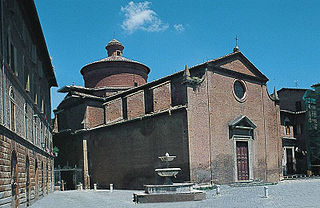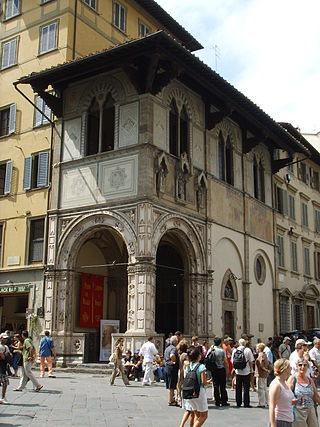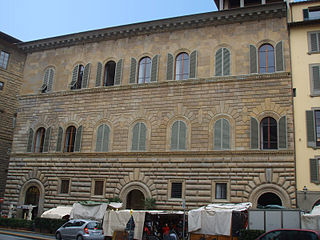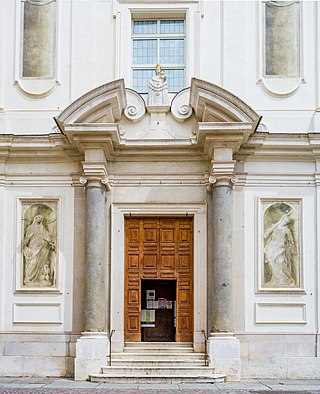The Column of Santa Felicita is a monumental column with Corinthian capital standing in front of the church of Santa Felicita in Florence, region of Tuscany, Italy.

The Column of Santa Felicita is a monumental column with Corinthian capital standing in front of the church of Santa Felicita in Florence, region of Tuscany, Italy.

Putatively the column was erected to celebrate the 13th-century victories or crusades led by the Dominican friar Peter of Verona against the Cathar heresy in Northern Italy. [1] In 1484, the capital had a terracotta statue Peter of Verona preaching, as he had to the Florentines and organizing his militia of the "Società di Santa Maria" used to persecute heretics. The column was financed by Amerigo De Rossi, whose ancestor was a follower of the Dominican preacher. There is some evidence that the column was erected earlier at the site of some former paleochristian tombs, and was surmounted by crosses.
The St Peter of Verona statue fell in 1723, but was replaced by a marble statue by Antonio Montauti, that itself was removed in the 19th century. [2] Further injury was added when the Germans, destroying the bridges to the Arno river, mined the access to Ponte Vecchio, shattering the column. It has been cobbled together by metal rings, and it subsists in the tiny piazza crowded by tourist booths, forlorn in state, secular in apparel, shorn of all emblems of prior purposes.

Peter of Verona, also known as Saint Peter Martyr and Saint Peter of Verona, was a 13th-century Italian Catholic priest. He was a Dominican friar and a celebrated preacher. He served as Inquisitor in Lombardy, was killed by an assassin, and was canonized as a Catholic saint 11 months after his death, making this the fastest canonization in history.

Fabriano is a town and comune of Ancona province in the Italian region of the Marche, at 325 metres (1,066 ft) above sea level. It lies in the Esino valley 44 kilometres (27 mi) upstream and southwest of Jesi; and 15 kilometres (9 mi) east-northeast of Fossato di Vico and 36 kilometres (22 mi) east of Gubbio. Its location on the main highway and rail line from Umbria to the Adriatic make it a mid-sized regional center in the Apennines. Fabriano is the headquarters of the giant appliance maker Indesit.

The Church of Santi Apostoli is a Romanesque-style, Roman Catholic church in the historic center of Florence, in the Tuscany region of Italy. It is among the oldest church buildings in Florence.

Settignano is a frazione on a hillside northeast of Florence, Italy. The little borgo of Settignano carries a familiar name for having produced three sculptors of the Florentine Renaissance, Desiderio da Settignano and the Gamberini brothers, better known as Bernardo Rossellino and Antonio Rossellino. The young Michelangelo lived with a sculptor and his wife in Settignano—in a farmhouse that is now the "Villa Michelangelo"— where his father owned a marble quarry. In 1511 another sculptor was born there, Bartolomeo Ammannati. The marble quarries of Settignano produced this series of sculptors.

Sant'Anna dei Lombardi,, and also known as Santa Maria di Monte Oliveto, is an ancient church and convent located in piazza Monteoliveto in central Naples, Italy. Across Monteoliveto street from the Fountain in the square is the Renaissance palace of Orsini di Gravina.

The chiesa di Sant'Anastasia, or the Basilica of Saint Anastasia is a church built by the Dominican Order in Verona, northern Italy. In Gothic style, it is the largest church in the city, located in its most ancient district, near the Ponte Pietra.

Santo Spirito is a Renaissance style, Roman Catholic church located in piazza Santo Spirito, where Via dei Pispini meets Vicolo del Sasso, in Siena, Italy.

The Loggia del Bigallo is a late Gothic building in Florence, region of Tuscany, Italy. It stands at the corner of Piazza San Giovanni and via Calzaioli; tradition holds the site near the Baptistry of Florence was donated by a benefactor.

Piazza della Repubblica is a city square in Florence, Italy. It was originally the site of the city's forum; then of its old ghetto, which was swept away during the improvement works, or Risanamento, initiated during the brief period when Florence was the capital of a reunited Italy—work that also created the city's avenues and boulevards. At that time, the Loggia del Pesce from the Mercato Vecchio was also moved to Piazza Ciompi. The square's Giubbe Rosse cafe has long been a meeting place for famous artists and writers, notably those of Futurism.

Palazzo Gondi is a palace in Florence, Italy, located a block from Piazza della Signoria. It was built in 1490 under design by Giuliano da Sangallo, who was inspired by other major works of stately buildings in the city, such as Palazzo Medici and Palazzo Strozzi. Among the elements borrowed from these earlier works are the cube-shape set around a central courtyard, the ashlar sloping on each of three floors, and the arched windows.

Santa Caterina da Siena is a Baroque architecture, Roman Catholic church in the district Venezia Nuova central Livorno, region of Tuscany, Italy. It stands in front of the Piazza dei Domenicani. The church is notable for its tall octagonal dome and lantern rising above a rough, unfinished rectangular base.

The Triumphal Arch of the Lorraine located in Piazza della Libertà in Florence, Italy, is an 18th-century, monumental triumphal arch, bypassed by the viali di Circonvallazione that skirt Florence through the space once girded by its 16th-century walls. The piazza stands at the northernmost end of Via Cavour, Florence, region of Tuscany, Italy.

The Teatro Goldoni of Florence was first opened in 1817 at the site of the former Annalena monastery in Oltrarno, region of Tuscany, Italy. The theater, dedicated to the playwright Carlo Goldoni, has a main facade on the narrow Via Santa Maria #15, it is near the corner with Via de Caldaie.

The Column of Saint Zanobi is a monumental marble column, surmounted by a cross above a crown of fire, located just north of the Bapstistery of San Giovanni in Florence, Italy.

Column of Justice is an ancient Roman marble Doric column re-erected by the Florentine Medici dynasty in the Renaissance as a free-standing victory monument with a porphyry statue of Justice at the top. It stands in the Piazza Santa Trinita, in central Florence, region of Tuscany, Italy.

Santa Maria della Carità or just known as the Carità, or the church of the Buon Pastore, is a Baroque-style, Roman Catholic church located on Via dei Musei corner via Rosa in Brescia, region of Lombardy, Italy.

Santa Caterina d'Alessandria or Saint Catherine of Alexandria is a Roman Catholic church with a main facade on Piazza Bellini, and a lateral Western facade facing the elaborate Fontana Pretoria, in the historic quarter of Kalsa in the city of Palermo, region of Sicily, Italy. In front of the main facade, across the piazza Bellini, rise the older churches of San Cataldo and Santa Maria dell'Ammiraglio, while across Piazza Pretoria is the Theatine church of San Giuseppe and the entrance to the Quattro Canti. Refurbished over the centuries, the church retains elements and decorations from the Renaissance, Baroque, and late-Baroque (Rococo) eras. This church is distinct from the Oratorio di Santa Caterina found in the Olivella neighborhood.

The Church of Saint Ignatius is a Baroque church of Palermo. It is located in the ancient neighborhood of the Olivella, in the quarter of the Loggia, within the historic centre of Palermo.

Santa Maria Assunta is a Roman Catholic parish church located in Settignano, a frazione of Florence in the region of Tuscany, Italy.